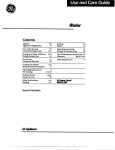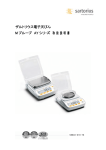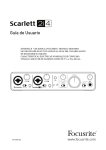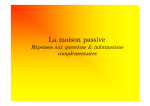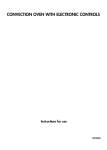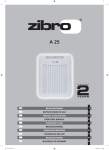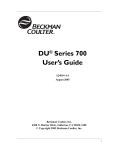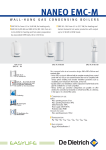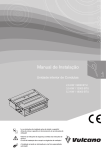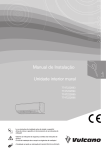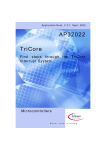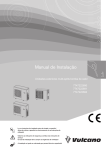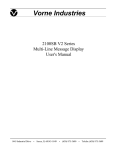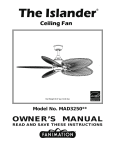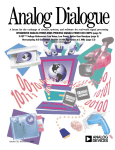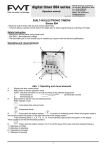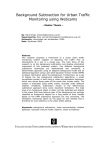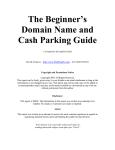Download 1 - SBSBattery
Transcript
~ SBS Storage Battery Systems, Inc. Since 1915 SBS MODEL BCT-SOOO LOAD BANK (DC RESISTIVE) Part Number K492D26649 150A @ 21/42/105 VDC 171 A @ 24/481120 VDC 16 October 1996 Rev. 15 July 1997 SBS MODEL BCT-SOOO LOAD BANK (DC RESISTIVE) Part Number K492D26649 TABLE OF CONTENTS section I SAFETY CONSIDERATIONS · 1-1 section II DESCRIPTION · 2-1 section III INSTALLATION . . · 3-1 section IV OPERATION • 4-1 section V MAINTENANCE · 5-1 section VI REPLACEMENT PARTS LIST . · 6-1 APPENDIX Load Bank Troubleshooting Guide DRAWINGS SB2615 Load Bank (Outline Drawing) C23218 Schematic/Interconnection, Load Bank K492D26649 Load Bank DTB/kv 10/16/96 -i- SBS MODEL BCT-5000 LOAD BANK (DC RESISTIVE) Part Number K492D26649 SECTION I SAFETY CONSIDERATIONS Throughout this manual, you will find WARNING and CAUTION statements. Personal injury to an operator using or repairing the equipment may occur if a WARNING statement is ignored. Damage to the equipment and potentially hazardous conditions for personnel may occur if a CAUTION statement is ignored. Each unit is safety checked for opens and shorts, and the insulation is high potential tested to insure safe operation. All safety devices have been proven reliable as part of the testing procedure of each unit. As part of your safety program, an initial inspection after receiving the unit(s) and periodic preventive maintenance and safety inspections should be conducted to insure the reliability and safety built into your Load Bank. The Model BCT-5000 Load Bank is an industrial test unit designed to be used indoors. However, because the nature of the Load Bank function is the dissipation of electrical energy, there are inherent dangers to the operator and to the equipment. These dangers shall be outlined in this section. Electrical energy is transformed into heat by the resistor elements. The heat is removed from the Load Bank by airflow through the resistor elements. . If there are any restrictions or stoppage of .airflow, the Load Bank may overheat and may even start a fire. The following recommendations are made: 1. Read the manual before operating the Load Bank. 2. Run an approved ground wire from the Load Bank ground terminal (GND) , located on the lower right side of the control panel., to the battery supply under test. Run an approved ground wire from the supply under test frame to a good earth ground. Size ground wire in accordance with National Electrical Code and any local codes. 3. Do not bypass OVER TEMP SAFETY switches to prevent nuisance tripping. The switches will drop out the load if insufficient cooling air is reaching the elements. DTB/kv 10116/96 1-1 SBS Model BCf-5000 Load Bank (DC Resistive) Part Number K492D26649 Safety Considerations 4. The Load Bank is not internally protected from short circuit faults or overcurrent applications. Therefore, it is recommended that the battery supply being tested contain a fuse or that an external fuse be added between the battery supply and the Load Bank input terminals. 5. Replace the lights on the control panel if they are burned out. The lights serve as indicators that the Load Bank is overheating, that reverse polarity is connected at input terminals, or that an over or under voltage condition and/or control power is present. This is important to the operation of the unit and the safety of the operator. ************************************************** WARNING Personal injury from electrical shock may result if power is not disconnected before servicing. Maintenance work must be done only by qualified personnel. ************************************************** 6. Maintenance should be performed with no power on the unit. The majority of troubleshooting can be performed with an ohmmeter. 7. venting the heated air from the exhaust toward overhead cables, sprinkler systems, or into a room with insufficient volume or make-up air, is a potential hazard. The Load Bank should be used in a cool, well-ventilated area. 8. Allow cool room air to pass into the uni t to cool the elements. Do not allow the unit to be placed where hot exhaust air can recirculate back through the unit causing a constant rise in cooling air temperature. 9. After running a load test, residual heat may be removed from the Load Bank by allowing the blower to operate for a few minutes after load is removed. This procedure is not required for maintaining Load Bank' integrity, but it may guard operating "personnel from possible burn· injuries. 10. The operator should avoid coming in contact with the resistor elements or surrounding covers during and for some time after operation. These portions of the Load Bank become quite hot and may result in a serious burn should contact be made with them. DTB/kv 10/16/96 1-2 SBS Model BCT-5000 Load Bank O)C Resistive) Part Number K492D26649 Safety Considerations 11. Do not allow objects to enter or block the air intake or exhaust of the Load Bank. A blockage would cause Load Bank overheating. If an object enters the screens, it will cause damage to the resistor elements, possibly shorting them and causing shock and fire hazards. 12. Emergency Shutdown Procedure: In an emergency, disconnect the load and fans using the CONTROL POWER ON/OFF switch; then deactivate the battery source under test. The CONTROL POWER ON/OFF switch will disconnect both the load steps and the fans. 13. An approved electrical fire extinguisher should be on hand at all times. 14. It is the responsibility of the customer to take diligent care in operating the Load Bank. The National Electrical Code (NEC) , sound local electrical and safety codes, and the Occupational Safety and Health Act (OSHA) should be followed when installing the equipment to reduce hazards to persons and property. 15. Observe proper polarity when connecting the Load Bank to the battery source. If the Load Bank is not connected properly, the meter will not monitor the load. 16. The Load Bank should never be left unattended while it is operating. 17. Read and heed all WARNING and CAUTION statements manual. DTB/kv 10116/96 1-3 in the SBS Model BCf-5000 Load Bank (DC Resistive) Part Number K492D26649 SECTION II DESCRIPTION The Model BCT-5000 Load Bank is an indoor" portable, self-contained unit designed for electrically loading and testing 24/48/120 VDC The Load Bank is designed for production line battery supplies. and job site use. The loading capability at 21/42/105 VDC consists of six steps for a total of 150 Amps. They are: 5, 10, 10, 25, 50, and 50 Amps. When applying nominal voltages 24/48/120 VDC, the total load increases to 171A with load steps 5.7, 11.4, 11.4, 28.5, 57.1, and 57.1 amps. ************************************************** C AUT ION DO NOT operate the Load Bank at voltages greater than 20% the rated voltage as this will cause a catastrophic failure in the Load Bank. ************************************************** CONTROL PANEL Load application is controlled from the integral mounted control panel at the front of the Load Bank. Controls and indicators are located on the Load Bank control panel as follows. 1. The CONTROL POWER ON/OFF switch controls power to the unit, power to load steps, and fan power. 2. The MASTER LOAD switch controls power to the load steps. The MASTER LOAD switch will also reset Load Bank controls after an over/unde~ voltage condi"tion. 3. The OVER TEMP indicator lamp lights if the Load Bank overheats. This lamp lights momentarily when power is turned on, but goes off when the safety circuit is cleared. DTB/kv 10116/96, Rev. 213/97 2-1 SBS Model BCf-5000 Load Bank Ene Resistive) Part Number K492D26649 Description 4. The CONTROL POWER indicator lamp energizes when voltage is applied to the 120V receptacle and the CONTROL POWER switch is ON. 5. The OVER/UNDER VOLTS indicator lamp energizes when voltages greater than 28V or less than 18 volts is applied to the Load Bank 24 VDC input terminals. For the 48 VDC terminals, the limits are 56V and 36V. For the 120 VDC terminals, the limits are 140V and 90V. Note that these limit values may vary as much as 5%. 6. The load step ON/OFF switches are used to apply or remove load steps at the ratings listed above each switch. 7. The digital meter monitors the load applied. Meter monitoring banana style plug terminals are located on the control panel of the Load Bank. This allows for remote meter monitoring at the source being tested. Voltage, current, elapsed time, and amp-hours are units monitored to an accuracy of ±1% of full scale. Full scale of volts and elapsed time is 199. Full scale of current and amp-hours is 1999. Note that the DC voltages that are not pure DC may not give accurate data. The meter monitors volts and amps with an averaging computation method. ENCLOSURE The Load Bank is shown on Outline Drawing SB2615 and is 22 inches high, 25 inches deep, and 22 inches wide. The screened air intake is located on one side of the unit, and exhaust is discharged outward through the opposite side screened opening. DTB/kv 10/16/96, Rev. 213/97 2-2 SBS Model BCI'-5000 Load Bank (DC Resistive) Part Number K492D26649 Description POWER CONNECTIONS ************************************************** C AUT ION Never exceed the rated voltage by more than 20% as this will cause the Load Bank to overheat. Failure to connect the battery supply under test to the correct polarity on the Load Bank will prevent meter from functioning. Refer to the Safety Considerations section of this manual. ************************************************** Control and fan power requirements are 120 VAC at approximately 5 Amps. This power is accepted through the 120V receptacle on the control panel. Use line cord PIN 390874. To connect load power, attach load cables (B25464 supplied separately) to the input power~terminals on the front of the Load Bank. The terminals are labeled 120V, 48V, 24V, COMMON, and GROUND. The COMMON terminal 'is common to all voltages. Use the terminals that match the voltage application to be tested. WHEELIHANDLE/CORDRACK The Load Bank is provided with rear wheels and an extended handle for easy portability. The handle is also convenient for storage of load cables when the Load Bank is not being used. DTB/kv 10116/96, Rev. 3/7/97 2-3 SBS Model BCT-5000 Load Bank CDC Resistive) Part Number K492D26649 SECTION III INSTALLATION BEFORE INSTALLATION Inspect the Load Bank for obvious damage such as broken wires, broken or dented panels, cracked ceramic insulators, or any other component breakage that may have occurred in shipment. LOCATION The BCT-5000 is a portable, indoor Load Bank, and should be installed in a cool, well-ventilated area. Cool air must be continually available so the hot exhaust air can be dissipated and not recirculated through the unit. Install such that the inlet and exhaust panels have unrestricted airflow clearance. ************************************************** CAUTION Installation must prevent hot exhaust air from recirculating into the air intake. Inlet air temperatures exceeding 104°F may cause damage to the Load Bank. After installation, test the unit at full load and verify that the inlet air temperature does not exceed 104°F. ************************************************** AIRFLOW CONSIDERATIONS Even with an ample supply of cooling air, the Load Bank may overheat if it is not properly installed. There are two types of airflow problems that should be avoided: 1. Recirculating Airflow - If the hot, exhausted air is permitted to recirculate through the Load Bank, it will reach such a high temperature and low density that it will no longer cool the resistance elements. A Load Bank should not be installed so close to any surface as to reflect the exhausted air back DTB/k:v 10116/96, Rev. 317197 3-1 SBS Model BeT-SOOO Load Bank ~C Resistive) Part Number K492D26649 Installation to the air intake. When two or more Load Banks are being used, care must be taken in positioning the Load Banks so that the exhausted air of one unit does not feed the air intake of another. 2. Restriction of Cooling Air - Any obstruction located within two (2) feet of the inlet and exhaust screens will restrict the Load Bank's airflow. Airflow is also restricted when two or more Load Banks have air inlets positioned close to each other. This competition for cooling air causes a low pressure area, restricting adequate airflow. ************************************************** WARNING It is vitally important to install the Load Bank properly. Installation errors may result in a catastrophic failure. The temperature switches, and protective devices in the Load Bank, will guard against some of these problems. If protective circuitry prevents application of the load, determine the source of the problem. DO NOT DISABLE the TEMPERATURE SWITCHES. This causes a safety hazard and voids the warranty. The following installation instructions are critical to the safe operation of the Load Bank. Refer to the Safety Considerations section of this manual. ************************************************** POWER REQUIREMENTS The Load Bank derives its control/fan power from the control power receptacle on the Load Bank control panel. Use line cord P /N 390874. Control and fan power is derived at 120 VAC, approximately 5 Amps. The battery supply under test load ·connections are at the terminal·s mounted on the·. control panel. The terminals are identified as 120 Volts, 48 Volts, 24 Volts, and COMMON. Cables (B25464-1 and -2 supplied separately) are to be connected to the respective load terminals as required for the voltage rating of the supply to be tested. The COMMON terminal is common to all voltages. DTB/kv 10/16/96, Rev. 317197 3-2 SBS Model BCT-5000 Load Bank: EDC Resistive) Part Number K492D26649 Installation *************************************************** CAUTION The Load Bank is not internally protected from short circui t faul ts or overcurrent applications. Therefore, it is recommended that the battery supply being tested contain a fuse or that an external fuse be added between the battery supply and the Load Bank input terminals. *************************************************** Cables to the Load Bank should be of adequate size to handle maximum rated load according to the National Electrical Code and any local codes. A case ground terminal is provided on the lower right side of the control panel and must be connected to the battery under test frame, which in turn should be connected to a good earth ground. Use cable PIN B25464-3 for this connection. DTB/kv 10/16/96, Rev. 317197 3-3 SBS Model BeT-SOOO Load Bank (DC Resistive) Part Number K492D26649 SECTION IV OPERATION PURPOSE AND USE OF CONTROLS 1. CONTROL POWER ON/OFF switch - This switch turns on the cooling fans and powers the remainder of the control circuit. 2. OVER TEMP lamp - This lamp should momentarily light when MASTER LOAD switch is turned on. This shows the air safety circuit is working. The purpose of the OVER TEMP lamp is to warn the operator and remove the load to the Load Bank in case of improper cooling of the load elements. 3. Load step ON/OFF switches - Allow load steps to be applied or removed at the rating identified under each switch. 4. The MASTER LOAD switch controls power to the load steps. The MASTER LOAD switch will also reset Load Bank controls after an OVER/UNDER voltage condition. 5. The OVER/UNDERc.VOLTS indicator lamp energizes when voltages greater than 28V or less than 18 volts is applied to the Load Bank 24 VDC input terminals. For- the 48 VDC terminals, the limits are 56V and 36V. For the 120 VDC terminals, the limits are 140V and 90V. Note that these limit values may vary as much as 5%. 6. The digital meter monitors the load applied. Meter monitoring banana style plug terminals are located on the control panel of the Load Bank. This allows for remote meter monitoring at the source being tested. Voltage, current, elapsed time, and amp-hours are units monitored to an accuracy of ±1% of full scale. Full scale of volts and elapSed time is 199. Full scale of current and amp-hours is 1999. Note that DC voltages that are not pure DC may not give accurate data. The meter monitors volts and amps with- an averaging computation method. DTB/kv 10116/96, Rev. 2/3197 4-1 SBS Model BCT-5000 Load Bank: ~C Resistive) Part Number K492D26649 Operation LOAD BANK OPERATION All tests start with control panel switches in the OFF position. ************************************************** C AUT ION Before energizing any load, verify that load voltage does not exceed rated voltage of Load Bank by more than 20%. ************************************************** The unit is energized by the CONTROL POWER ON/OFF switch. This switch also energizes the cooling fans. Upon energizing the unit, the red OVER TEMP lamp will light momentarily until the enclosed temperature switches signal that safe operating temperature is present, at which time the light goes off. The load steps are enabled by energizing the MASTER LOAD switch. If Load Bank voltage applied to the power terminals is between the volt sensor settings, activating the appropriate load switches will apply the load to the battery supply under test. If not, the MASTER LOAD switch will have to be reset by toggling on and off while voltage applied is within volt sensor settings. If the operating temperature in the Load Bank reaches an unsafe level, the temperature switches disconnect the load and the red OVER TEMP lamp will light. ************************************************** C AUT ION Do not attempt operation if the fans are not running. Fan inlet and exhaust must be unrestricted. The operation of the fan is vi tal to the safe operation of this Load Bank. If the OVER TEMP indicator light comes on and stays on for more than a few seconds without the load dropping out, shut off the MASTER LOAD switch .at once. Remove all power to the unit and check for proper operation of the fan safety circuit. Failure to correct an over temperature condition will result in the destruction of the Load Bank. Refer to the Safety Considerations section of this manual. ************************************************** DTB/kv 10/16/96, Rev. 213/97 4-2 SBS Model BCf-5000 Load Bank: (DC Resistive) Part Number K492D26649 Operation OPERATING INSTRUCTIONS ************************************************** C AUT ION Never exceed the rated voltage by more than 20% as this will cause the Load Bank to overheat. Failure to connect the battery source to the correct polarity on the Load Bank will prevent meter from functioning. Refer to the Safety Considerations section of this manual. ************************************************** 1. with all control panel switches in the OFF position, connect the 120V line cord and the appropriate battery supply leads to the Load Bank. 2. Connect cable from Load Bank ground terminal to battery supply under test frame. 3. Connect battery supply- under test ground. 4. Activate battery supply under test. 5. Move the CONTROL POWER switch to the ON position. Verify that the red OVER TEMP lamp momentarily lights and then goes off. 6. Enable the LOAD STEP switches by moving the MASTER LOAD switch to the ON position. Activate the desired load using control panel load switches. 7. After running tests, remove the load by moving the MASTER LOAD ON/OFF switch to the OFF position. Accumulated heat may be removed from the Load Bank by allowing the cooling fans to operate for a few minutes with load removed. This procedure is not required for maintaining Load Bank integrity, but it may guard operating pers_onnel from possible burn injuries . . DTB/Iev 10/16/96, Rev. 317197 4-3 frame to a good earth SBS Model BCT-5000 Load Bank ~C Resistive) Part Number K492D26649 Operation ************************************************** WARNING DO NOT touch the exhaust screen during, and for some time after operation. The screen will become hot from the exhausted heat and may cause a serious burn. Refer to the Safety Considerations section of this manual. DO NOT allow screens. objects to enter or block ************************************************** 8. Move the CONTROL POWER ON/OFF switch to the OFF position. 9. Turn OFF the battery supply under test and disconnect all leads from the Load Bank. COMMON BATTERY TEST PROCEDURES To discharge test stationary substation, :ups, or telecom batteries, either run a complete acceptance load test on the battery (ideal) or simply remove a percentage' of the load with each test and compare the lowest voltage at the end of the like repeated tests. ACCEPTANCE TEST TIME AND DISCHARGE RATE CALCULATION 1. The discharge time and end point voltage selected should be one at which the battery has a published rating and is approximately the same as that of the intended application. 2. The discharge rate (amperes or watts/cell) to a specific end point voltage for the selected time, as taken from the published ratings for the battery, must be adjusted for battery temperature if outside the range of 75 to 80 deg .. F. For elevated temperatures, the rate will be increased while for cooler temperatures, ,the rate is reduced. The temperatur'e adjustment factors are noted in Table 1. For example, if a cell having a one hour rating of 61.5 amperes to 1.75 V/cell @ 77 deg. F were tested at 60 deg. F, the discharge rate used for a one hour discharge would be: 61.5 amperes x 0.93 - 57.2 amperes DTB/kv 10116/96, Rev. 5112/97 4-4 SBS Model BCf-5000 Load Bank <pC Resistive) Part Number K492D26649 Operation For accuracy, capacity tests should be performed between 60 deg. F and 90 deg. F, and as close to 77 deg. F as possible. This is because the temperature corrections factor can vary a few percent from Table 1 due to battery design factors. ACCEPTANCE CAPACITY TEST 1. Equipment Requirements a. b. c. d. 2. BCT-5000 Load Bank Digital Voltmeter: to monitor individual cells/unit voltage during discharge. Hydrometer (digital Preferred; e.e. SBS-2002 or SBS-1001. other Nonessential Items: Non Contact Thermometer, SBS/Raytek ST-2 or ST-6 and MicroOhm Meter, SBS #5600. Performance a. Connect BCT-5000 Load Bank to batteries as covered in paragraph 4-2 of manual. If parallel strings are being tested, the individual string current and total current must both be monitored. b. Measure and record the float voltage of each cell/unit and assure all cells/units are floating properly. c. Remove the charging current from the battery. If the charger cannot be disconnected, the current being drawn by the load must be increased to compensate for the current being supplied by the charger. d. with the Load Bank OFF, connect it to the battery. e. Reset the timer and turn the load bank ON, adjusting and maintaining it for the appropriate rate (amps or watts) per sections 4-2, 4-3, and 4-4 of user manual. f. Record the battery discharge voltage at the start and end of the test and periodically throughout the test as many times as practical. The individual cell/unit. voltages shall also be measured and recorded as often as is practical during the discharge. The number of sets of discharge readings must be 3 or more. The longer the test duration, the more readings should be taken so the capacity of individual cells can be analyzed. DTB/kv 5112/97, Rev. 7/15197 4-5 SBS Model BCf-5000 Load Bank (DC Resistive) Part Number K492D26649 Operation continue the discharge beyond the required battery end point voltage (e.g., 1.85 VIC) to a lower rated voltage (e.g. 1.75) when possible to assure most cells actually discharge to the required end point. Terminate the capacity test when the battery is discharged to the predetermined system end point voltage, a cell or unit is going into reversal, or a safety hazard is noted. CALCULATING BATTERY CAPACITY The % rated capacity is calculated as: Actual Discharge Time Specified Discharge Time % rated capacity @ 77 deg. F To specified end point voltage x 100% PARTIAL CAPACITY LOAD TESTING Partial capacity load testing is an approved method of performing load tests. By comparing discharge voltage readings under identical test conditions, meaningful data can be collected. This test can be done, normally without removing more than 50% of the battery capacity, leaving 50% to handle the load should the AC power be interrupted soon after the test has been completed. This partial load test should be done about four times per year. The test takes less than one hour to perform and no back up (spare) batteries are needed.. The comparison data is reliable test data on the batteries' condition, second only to a full discharge test. RECOMMENDED PARTIAL LOAD TEST CURRENTS Look at the battery manufacturer's ampere current capability to 1.75 VPC (volts per cell). Find the current that is below 150 amps and use that current for the test; i.e., if battery is rated to deliver 150 amperes for one hour, test at 150 amps for 50% of one hour (30 minutes). Do not be concerned about maintaining exactly 150 amps; just be sure to always have the same load switch on for exactly 30 minutes. At the end of t~e test, you should record the lowest voltage at the 30 minute mark. If you want to test each cell, do so after the 30 minute voltage is recorded. Be sure to time each test the same when doing the same battery on subsequent tests. You will still have about 50% capacity remaining in the battery system. If any battery has failed, you must replace it as soon as possible. Be sure to use Table 1 load correction tables for temperature compensation. DTB/kv 5112/97, Rev. 7/15197 4-6 SBS Model Bcr-5000 Load Bank (DC Resistive) Part Number K492D26649 Operation since you may have many batteries that are the same model, make, etc., you can compare test data on like batteries as well. Call SBS with your battery types and quanti ties, provide a recommended test for each. and we will If a partial load test shows lower end of test readings, your battery is failing or nearing its life's end (see Life Curve Data Table 2). You may also want to run a f~ll performance test (same as acceptance test) to confirm your findings. Example of Typical 200 AH Cell Test - 50% Depth of Discharge (D of D) 8 Hr. Rated AH Capacity 200 5 Min. 1 Min. Ph 10 Min. 15 Min. 20 Min. 30 Min. 1 Hr. Hrs. 3 Hrs. 5 Hrs. 8 Hrs. 234 210 190 154 100 80 50 34 25 Ampere Load Capacity to 1.75 VPC I 296 I 268 I You could either take 100 amps out for 30 minutes (based on 50% of one hour) or 80 amps out for 45~ minutes (based on the 1~ hour rate). Example of Typical 24 AH Battery Test 8 Hr. Rated AH Capacity 24 5 Min. 10 Min. 15 Min. 30 Min. 1 Hr. 2 Hrs. 3 Hrs. 5 Hrs. 6 Hrs. 8 Hrs. 10 Hrs. 32.5 20.5 13.3 8.25 6.25 4.00 3.50 2.75 2.35 Ampere Load Capacity to 1.75 VPC I 56.5 I 41.3 I 24 AH - 8 Hr. Rate Having a: 30 Min. Rate of 20.5 amps to 1.75 VPC 1 Hr. Rate of 13 amps ~o 1.75 VPC You could either load test at 20 amps for 15 minutes or 13 amps for 30 minutes. (50% Depth of Discharge) What is important is not whether your current is set exactly but that you use the same load steps on each subsequent partial load test. DTB/kv 5112/97, Rev. 7/15197 4-7 SBS Model BCf-5000 Load Bank (PC Resistive) Part Number K492D26649 Operation TABLE 1 BATTERY LOAD CORRECTION FACTOR VS. BATTERY TEMPERATURE Battery Temperature CDeg. I FDeg. Battery Load Correction Factor 15 Min Rate 11 Hour Rate 15 Hour Rate Is Hour Rate I 20 Hour Rate -9.4 15 .550 .580 .650 .705 .735 -6.7 20 .660 .630 .690 .735 .765 -3.9 25 .650 .680 .735 .765 .790 -1.1 30 .700 .725 .765 .790 .815 1.7 35 .740 .765 .800 .820 .840 4.4 40 .780 .800 .830 .845 .865 7.2 45 .820 .840 .855 .870 .890 10.0 50 .860 .865 .880 .895 .910 12.8 55 .875 .890 .910 .920 .930 15.6 60 .920 .930 .940 .945 .950 18.3 65 .940 .950 .955 .960 .965 21.1 70 .960 .970 .975 .978 .980 25.0 77 1.00 1.000 1.000 1.000 1.000 26.7 80 1.010 1.005 1.003 1.002 1.001 29.4 85 1.030 1.020 1.015 1.010 1.005 32.2 90 1.040 .1.025 1.020 1.015 1.010 35.0 95 1.050 1.030 1.025 1.020 1.015 37.8 100 1.060 1.040 1.030 1.025 1.020 Watts per Cell and Ampere's Load Derating vs. Temperature Note: 1) 2) Perform acceptance tests only in the range of 60 deg. to 90 deg. F and preferably as near to 77 deg. F as possible. When conducting constant power (watts) capacity tests, the battery load in watts is equal to the terminal voltage times the discharge current in amperes. IDGH CURRENT MOMENTARY LOADS High current momentary loads also provide a way of checking the integrity of batteries, allowing you to identify weak cells and poor connections. These tests can be done any time while taking DTB/kv 5112/97, Rev. 7115197 4-8 SBS Model BCf-5000 Load Bank (pC Resistive) Part Number K492D26649 Operation little energy from the batteries (because it is a high current over a short time, less than one minute typical). Call SBS for our high rate test recommendations. This short test will provide more information than other non-load testing in terms of guaranteed performance. TABLE 2 TYPICAL LIFE CURVE OF BATTERY 100 % / 80 % C A 60 % P 40 % A C I T ~ "" 20 % 0 % Y LIFE YEARS (TIME LINE) D6648D1LAN Battery Load testing is the only dependable procedure by which battery condition and performance can be determined. Lack of load testing has resulted in losses of millions of dollars reported by companies wi th" substations, power generating, and data center failures. Call SBS at 1-800-554-2243 for answers to any battery system questions. DTB/kv 5/12/97, Rev. 7/15197 4-9 ESD PRECAUTIONARY GUIDELINES C AUT ION Certain circuit card assemblies and their components, typically integrated circuits, may be damaged by seemingly undetectable electrostatic discharge (ESD). Care must be exercised during handling/repair of these items. Use electrostatic discharge precautionary procedures. The following guidelines are not necessarily all inclusive but rather serve as reminders for good shop practices for the handling/ repair of ESD sensitive circuit card assemblies and devices. Store ESD sensitive items in their original containers. These items are often marked with the symbol shown at the top of this page. Put on a grounded wrist strap before handling any ESD sensitive item. Clear work area of Styrofoam®*, plastic, and vinyl items such as coffee cups. Handle ESD connectors. i terns by the body, never the open edge Never slide ESD sensitive items over any surface. Transport ESD sensitive items in a static container to a static-free work station. shielding If a static-free work station is not available, ground the transport container before removing or inserting an ESD item. Electric tools used during repair should be grounded. For example, use only anti-static type solder suckers and grounded tip soldering irons. Discharge non-electric tools before use. Pack ESD i terns in static shielding containers before shipping them to Avtron for repair. * Styrofoam® is a registered trademark of Dow Chemical. SBS Model BCT-5000 Load Bank: QJC Resistive) Part Number K492D26649 SECTION V MAINTENANCE To provide long equipment life and to redpce the chance of electric shock, fires, and personal injury, good maintenance procedures must be used. Before servicing, review the Safety Considerations section of this manual. The following examples of scheduled maintenance procedures are not intended to be all-inclusive, but must be accomplished to maintain the equipment in a good, safe condition. All maintenance work must be done only by qualified personnel. ******************************************************* WARNING Personal injury from electrical shock or from the moving fan blades may result if power is not disconnected from the Load Bank prior to performing maintenance procedures. Refer to the Safety Considerations section of this manual. ******************************************************* DAILY 1. Remove any restrictions to airflow through the Load Bank. 2. Check the screens to make sure that no objects have blocked or entered the openings. 3. Verify that the airflow is in the proper direction. 4. Assure that there is no recirculation of the exhaust air through tqe Load Bank. DTB/kv 10/16/96 5-1 SBS Model BCf-5000 Load Bank Ene Resistive) Part Number K492D26649 Maintenance THREE MONTHS OR 500 HOURS 1. Remove access panels and screens. 2. Inspect the load resistors for mechanical breakdown which is demonstrated by excessive sagging of the elements. Replace with new resistor elements as required. I 3. Inspect for loose hardware or loose connections. where required. Tighten I 4. Inspect all connections for oxidation or corrosion. connection or replace the hardware where required. Clean the 5. Inspect magnetic contactors to make sure that the contacts are not severely pitted or corroded. The contacts must move freely and be properly seated. 6. Clean all dirt and debris out of the Load Bank. This can be accomplished by blowing the inside of the unit with clean, dry compressed air (not to exceed 40 PSI). Eye protection should be worn when cleaning the Load Bank with compressed air. 7. Inspect all the wiring for any sign of insulation failure. 8. Replace all access panels and screens. fastening hardware securely. 9. Check the indicator lamp on the control panel. Tighten all the PARTS REPLACEMENT Access to any component is easily made with the removal of the cover panels. Maj or components in the unit are listed in the replacement parts list. DTB/kv 10116/96 5-2 SBS Model BCf-5000 Load Bank: gJC Resistive) Part Number K492D26649 SECTION VI REPLACEMENT PARTS LIST INTRODUCTION The parts list in this section contains the description, quantity required, and part numbers for each listed part. The list also includes, where appropriate, the manufacturer's part number and federal code number, as well as schematic reference designators to facilitate troubleshooting. Every effort has been made to insure the accuracy of this information. However, changes are sometimes necessary and revisions to the parts list may be made at any time without notice. REFERENCE DESIGNATORS service personnel may use this parts list along with the system schematics to identify and order replaceable parts. The reference designators were carefully selected and matched to those on the schematic diagrams and equipment to simplify the troubleshooting and repair process. When ordering replacement parts, be certain to state the part's description and part number, not the schematic reference designator number. Also include the model and serial number of the equipment. MANUFACTURERS' FEDERAL CODE NUMBERS The manufacturer and part number column contains, in parentheses, the Commercial and Government Entity code number (CAGE code), a five character string listed in H4-1/H4-2. This CAGE code identifies the manufacturer of the listed part. The following is a numerical cross-reference listing of CAGE codes to manufacturers' names and addresses. DTB/kv 10/16/96 6-1 SBS Model BCf-5000 Load Bank (DC Resistive) Part Number K492D26649 Replacement Parts FEDERAL CODE NUMBER LIST 03030 Empro Mfg. Co. Inc. 10920 E. 59th st. P.O. Box 26060 Indianapolis, IN 46226 63681 Crouzet Corp. (Formerly Syrelec corp.) 3237 Commander Dr. Carrollton, TX 75006-2503 06352 Empire Products Inc. CAM-LOK Div. Subdivision of KDI Corp. Cincinnati, OR 71400 Cooper Industries Inc. Bussmann Div. 114 Old State Rd. Ballwin, MO 63021-5942 12066 Ohio Semitronics, Inc. 4242 Reynolds Dr. Hilliard, OH 43026-1260 71785 TRW Cinch Conn'ectors 1501 Morse Ave. Elk Grove Village, IL 60007 15605 Eaton corporation Administrative & Technical Center 4201 N. 27th st. Milwaukee, WI 53216 73559 Carlingswitch Inc. 60 Johnson Ave. Plainville, CT 06062-1156 16428 Cooper Industries Belden Division 350 N.W. N st. Richmond, IN 47374 77342 Potter & Brumfield Inc. 200 S. Richland Creek Dr. Princeton, IN 47671-0001 5S447 Test Probes Inc. LaJolla, CA 92037 82807 Milwaukee Resistor Corp. 8920 W. Heather Ave. P.O. Box 24200 Milwaukee, WI 53224-0200 51107 Diversified Electronics 320 E. Main st. P.O. Box 207 Leesburg, FL 34748-0207 72619 REPLACED BY: 83330 Dialight Corp. Manasquan Div. 1913 Atlantic Ave. Manasquan, NJ 08736~1005 59270 Selco Products Inc. 7580 Stage Rd. Buena Park, CA 90621-1224 63279 Weidmuller Terminations. 821 Southlake Blvd. Richmond, VA 23236-3917 DTB/kv 10116/96, Rev. 317197 6-2 SBS Model BCf-5000 Load Bank (DC Resistive) Part Number K492D26649 Replacement Parts REPLACEMENT PARTS LIST SCHEMATIC REFERENCE MANUFACTURER and PART NO. DESCRIPTION D26649 C23218 AWR400 AWR12 00 AWR200 AWR600 A23368-1 LOAD BANK .SCHEMATIC/INTCON DIAGRAM • RESISTOR, 4 OHM • RESISTOR, 12 OHM • RESISTOR, 2 OHM • RESISTOR, 6 OHM .RESISTANCE ELEMENT R31,32 R33 R34,35,37,38 R36,39 R4,5,7,8,10, 11,13,14, 16,17 R6,9,12,15,18 .RESISTANCE ELEMENT • INSULATOR, .500+/-.005 X .385+/-.005 X .530+/-.006 • INSULATOR, .370+/-.005 X .195+/-.005 X 1.195+/-.012 .TUBE, INSUL; .530+/-.005 X .330+/-.005 X 2.00+/-01 • INSULATOR, CERAMIC; .500+/-.005 X .375+/-.005 X .625+/-.010, S-151 • THERMOSTAT: 300F OPENS ON TEMP S9,10 RISE • RELAY; 3P, N.O., 600 VAC, 35A @ K1 0.05PF, 120 VAC, 60 HZ COIL • RELAY; 3P N.O., 65A @ 600V RES, K2,3 52A @ 600V IND, 120 VAC COIL • RELAY, VOLTAGE SENSING K4 XK4 • SOCKET K7 • RELAY K6 • RELAY, 120 VAC • BRACKET, END, TERMINAL BLOCK K8,9 • RELAY TB1 .TERMINAL BOARD BARRIER TYPE XTB1 .INSULATION ELEC, MARKER STRIP R20 • SHUNT, INSTRUMENT; 0-100MV .FUSE, 5 AMP, 600V F1 XF1 R21,24 M1 Form No. DC~ 0-20'OA, .FUSEHOLDER FOR 13/32 X 1-1/2 FUSE • RESISTOR, CARBON FILM, 1/2W, 1%, 10 KOHM • METER, DIGITAL; DC VOLTS, AMPS, AMP HOUR & ELAPSED TIME m DTB/kv 10/16/96, Rev. 213/97 6-3 PIN (59270) OA-300 ABB CONTROLS B30DC-1 ABB CONTROLS B50DC-1 (51107 ) VBA-1201 WITH 100-54-80 BRACKET (77342 ) 27E123 ABB CONTROLS B9DC-1 (77342 ) KUP14A55-120 (63279) 3835.6 ABB CONTROLS B12DC-1 (71785) 10-141 (71785) MS-10-141 (03030) MLB""'!'200-100 (71400) KTK-R-5 (71400) HPS-RR (12066) PTP-4605 QTY/ UNIT REF • 2 1 4 2 10 A23368-2 411182 60 411181 30 411141 105 411145 15 491012 2 351891 1 350350 2 350675 1 358206 1 351889 1 351170 1 364433 2 350830 2 364072 1 450087 1 337995 1 324211 1 324985 1 123037 2 338159 1 5 SBS Model BeT-5000 Load Bank (DC Resistive) Part Number K492D26649 Replacement Parts SCHEMATIC REFERENCE P1 DSl-3 Sl-6,8 El-5 Bl-6 R22 E6 E7 R21 S7 MANUFACTURER and PART NO. DESCRIPTION (16428) 17252 IMLEC NR151-110R (73559 ) • SWITCH, TOGGLE DPST, 4 TERM 2GK50-73 ON-NONE-OFF (06352) • CONNECTOR, RECP; FEMALE, BLK, #23/0 WIRE, 315A @ 120V, 3/8-16 STUI E1012-333 • FEET SUNONWEALTH ELEC. .FAN, MUFFIN; 115 CFM, 115V, SP100A1123XST 50/60 HZ, 20W, 3100 RPM, SLEEVE BRG, PIN CON • BRACKET, RESISTOR .LINE CORD .RESISTOR, 30 KOHM, 1/2W, 5% (5S447) • CABLE, BLACK 123501B (5S447) • CABLE, RED 12501R • CABLE, RED • CABLE, BLACK • CABLE, GREEN (83330) • PLUG, BLACK 257-103 (83330) • PLUG, RED 257-102 • RESISTOR, 10 KOHM, 1/2W, 1% (15605) • SWITCH 8373K107 (5S447) .ALLIGATOR CLIP, RED 126000/R (5S447) .ALLIGATOR CLIP, BLACK 126000/B • CONNECTOR, RECP., MALE, 15A, 250V, PANEL MNT. RECESSED .INDICATOR RED, 115 VAC Form No. 2TIA DTB/kY 10116196, Rev. 317197 6-4 QTY/ pIN UNIT 314681 1 329665 3 360589 7 315168 5 A23362 322140 4 6 A23443 390874 119815 424223 6 1 1 1 424224 1 B25464-1 B25464-2 B25464-3 366851 1 1 1 366852 1 123037 360598 1 367516 1 367517 1 1 1 APPENDIX LOAD BANK TROUBLESHOOTING GUIDE Servicing should always be done only trained, qualified service technicians. by ******************************************************** WARNING Be sure that all source's of power to the Load Bank are disconnected before servicing. ******************************************************** POSSIBLE CAUSES/REMEDIES PROBLEM 1. Load Bank ~ain power fails to come on. 1 a. .Main switch or circuit breaker is not closed. b. Unit is not connected according to the Schematic/Interconnection Diagram. c. Terminals were damaged during shipment. d. Fuses are blown. required.)* e. Fuse is blown in Load Bank control circuit. (Check and replace as required.)* (Check and replace as , 2. * Blower motor does not operate. f. Dirty or loose connection at Main Power Switch. a. Main switch or circuit breaker is not closed. b. Power is not connected to Load· Bank blower circuit. c. External power source is inadequate. d. Motor fuses are blown. reqiJ.ired.)* (Check and replace as· When checking fuses for continuity, be sure to remove all fuses from clips (in fuseblock or Disconnect Switch). Test each fuse individually, out of circuit. (If tested in circuit, there is the possibility of feedback which causes false readings. A blown fuse may still check out OK.) MP/kv 4/12/88, Rev. 317100 A-l Load Bank Troubleshooting Guide APPENDIX PROBLEM 2. 3. 4. 5. POSSIBLE CAUSES/REMEDIES Blower motor does not operate. (Cont. ) BLOWER FAILURE indicator lights, yet blower is operating. Fan blade is broken or not turning. Load step(s) cannot be energized. -. * e. Motor overload is tripped. f. Motor start is malfunctioning. g. Main Power Switch is inoperative. h. Connections are broken or loose. i. Motor shaft does not turn due to improper lubrication. (Replace or repair as necessary. ) a. Airflow re-strictions present at Load Bank intake or exhaust. b. Improper fan blade rotation or phase reversal. (Check fan motor power connections for proper phase sequence.) c. Air Differential Pressure Switch is malfunctioning. d. Blower Fail Relay is malfunctioning. a. Fan blade motion is obstructed. b. Fan blade is loose at hub or is not keyed properly. a. A blower failure exists. b. MASTER LOAD Switch is inoperative. c. Control power is inadequate. d. Fuse is blown in Load Bank control circuit or individual branch circuit ·_load fuse (if so equipped) is blown.' (Check and replace as required.)* e. Blower Fail Relay is malfunctioning. £. Load step switch is inoperative. g. Load step contactor is inoperative. h. Magnetic contactor has an open coil. i. Load step resistor is open. (See problem 2.) When checking fuses for continuity, be sure to remove all fuses from clips (in fuseblock or Disconnect Switch). Test each fuse individually, out of circuit. (If tested in circuit, there is the possibility of feedback which causes false readings. A blown fuse may still check out OK.) MP/kv 4112/88, Rev. 3/7/00 A-2 Load Bank Troubleshooting Guide APPENDIX POSSIBLE CAUSES/REMEDIES PROBLEM 6. 7. Contactor "chattering" exists. Load Bank or load step does not give rated load. a. Contacts and/or core are dirty or corroded. b. Connections to contactor coil are loose. c. Control circuit line voltage is too low. a. Applied load voltage is either derated or inadequate. b. Contactor does not close properly. c. Load step resistor element is open. d. One of the individual load branch circuit fuses is blown (if so equipped) • a. Fuses are undersized. * b. A short circuit exists in the blower or contr_ol circuit. * ~ 8. * Disconnect Switch fuses are blown. When checking fuses for continuity, be sure to remove all fuses from clips (in fuseblock or Disconnect Switch). Test each fuse individually, out of circuit. (If tested in circuit, there is the possibility of feedback which causes false readings. A blown fuse may still check out OK.) MP/kv 4112/&&, Rev. 3/7/00 A-3 REVISIONS DESCRIPTION ECN NO REV AD291 A REV PER ECN AD459 B REV PER ECN AD699 C REV PER ECN AD825 D REV PER ECN AD856 E REV PER ECN AD894 F REV PER ECN AD964 G REV PER ECN AD996 H REV PER ECN, ALSO SEE SHEET 2 & 3 AH399 J ITEM 20 WAS 351891, ITEM 23 WAS 351889, ITEM 27 WAS 350830. CD158 K REVISED SHEET 2 PER ECN AN489 L REV D SHT 1 & 3. ADD ITEM 49. .. - 76 75 74 73 72 71 70 69 68 67 66 65 64 63 62 61 60 59 58 57 56 55 54 53 52 51 4 1 1 1 1 1 1 1 1 3 14 2 4 2 6 1 1 1 2 1 1 1 1 1 5 5 1 12 AR 10 1 507011 B25464-3 B25464-2 367517 367516 360598 B25338-2 B25338-1 B25339 A23640-1 531046 AWR600 AWR200 461703 530078 366852 366851 A23616 492004 C23446 424223 424224 B25464-1 119815 516059 532537 507042 A17912 469004 A23443 C23218 ITEM NO. NO. REOD PART NO. 81 80 79 78 :.- 77 S7 , R36.39 R34.35.37,38 E7 E6 R22 REF DES SCREW 1/4-20 X 1.75 CABLE. POWER. GREEN CABLE. POWER. BLACK ALLI GATOR CLIP. BLACK ALLIGATOR CLIP. RED SWITCH BRACKET BRACKET BRACKET . BUS LINK WASHER. MICA RESISTOR. 6 OHM RESISTOR. 2 OHM COTTER PIN WASHER PLUG. RED PLUG. BLACK SHAFT WHEEL HANDLE. BOTTOM CABLE. BLACK CABLE. RED CABLE. POWER. RED RESISTOR. 30K NUT. 3/8-16 WASHER. 3/8 SCREW. 3/8-16 X 1.00 L BUS LINK GROMMET BRACKET. RESISTOR SCHEMATIC/WIRING DIAGRAM SEE SEE SEE SEE NOTE NOTE NOTE NOTE 1 1 1 1 SEE NOTE 1 SEE NOTE 1 SEE NOTE 1 DESCRIPTION 16 2 12 6 50 49 XBl-6 48 Bl-6 47 46 45 44 43 42 41 40 El-5 39 XK4 38 Sl-6.8 37 DSl-3 36 P1 35 M1 34 R21 33 XF1 32 F1 31 R20 30 XTB1 29 TBl 28 K8.9 27 26 25 K6 24 K7 23 K4 22 21 K2.3 20· K1 19 S9.10 18 17 16 15 14 13 12 R6.9.12.15.18 11 R4.5.7.8.10.11.13.14.16.17 10 XR31-39 9 R33 8 R31.32 7 6 5 4' 3 2 1 REF DES MATERIAl 509108 411086 366939 322140 390025 390874 A23362 A23641 440133 C20560 A23355-2 315168 358206 360589 329665 314681 338159 123037 324985 324211 337995 450087 364072 351650 364433 408189 351170 351687 350675 350350 351783 491012 523205 411145 411141 411181 411182 A21179 A23383 A23368-2 A23368-1 A23712 AWR1200 AWR400 C23223 C23222 C23219 C23220 C23221 D26696 1ft 1 4 1 2 1 1 5 1 7 3 1 1 1 1 1 1 1 1 2 2 14in 1 1 1 2 1 2 62 15 105 30 60 30 15 5 10 5 1 2 2 1 1 1 1 1 IIDJ NO: NO. REOD APPROVEO 3/7/97 5/31/00 BOHRER BOHRER BOHRER BOHRER BOHRER BOHRER BOHRER BOHRER PALINKAS FACKELMANN 8/14/02 R.FLAUTO 5/26/04 J.HUDSDN PALINKAS SCREW, 6 32 X 2.00" L SPANNER BUSHING TERMINAL FAN WIRE, #1/0 LINE CORD FEET HANDLE, TOP HANDLE SCOTCH CAL, SET PLATE. IDENT CONNECTOR. TERMINAL SOCKET SWITCH. TOGGLE LIGHT. INDICATOR CONNECTOR. RECP METER RESISTOR. 10K FUSEHOLDER FUSE. 5A SHUNT. 200A. 100mV INSULA TOR. TB TERMINAL BOARD RELAY END BRACKET MOUNTING RAIL RELAY RELAY RELAY RELAY RELAY SWITCH. THERMOSTATIC. 300' F NUT ASSEMBLED WASHER. 10-32 TUBE. INSULA TOR TUBE. INSULATOR TUBE. INSULATOR TUBE. INSULATOR SUPPORT. ROD BUSHING SUPPORT. ROD ELEMENT RESISTANCE ELEMENT RESISTANCE ELEMENT ROD. ELEMENT SUPPORT RESISTOR. 12 OHM RESISTOR. 4 OHM SUPPORT. SIDE • ELEMENT SUPPORT. ELEMENT PANEL. MACH .CONTROL COVER. MACH. TOP COVER. MACH. BACK CHASSIS. MACH SEE NOTE 1 -4- DESCRIPTION PART NO. MATERIAL LIST D. MAlERIAl LIST OF MATERIAL UNLESS OTHERWISE SPECIFIED DIMENSIONS ARE IN INCHES ANGLES±I' TOlERANCES: .xxx± DECIMAlS .XX± FINISH 4. 3. 2. 1. DATE 9/13/96 11/7/96 1/15/97 1/15/97 1/15/97 1/31/97 2/20/97 Zivkovic Zivkovic Zivkovic Zivkovic Zivkovic Martin GILLISSIE FACKELMANN SCHNEIDER DATE DRAIIIl 'CHECKED Zivkovic PLATE PER COAT PER PS NEXT ASSY UNLESS OTHERWISE SPECIFIED THE ABOVE NOTES APPLY USED ON APPLICATION BOHRER 8/8/96 ZIMMERMAN 8/8/96 t 1M. LOAD BANK (OUTLINE DWG SB2615) APVD PROO So I NO. SCALE FULL 1MODEL ANODIZED PER OTHER STORAGE BATTERY SYSTEMS, INC. 8/8/96 ENGAPVD PAINT PER PS REMOVE AUX CONTACTS FROM Kl-3,7-9 AND DISCARD. USE #8-32 HDW TO MOUNT DEVICES & FAB COMPONENTS. USE DEVICE LABELS TO IDENTIFY COMPONENTS. SHIPPED LOOSE 5 B5 Zivkovic 7131/96 CAGE rIG. NO. D PSF I8I REV 026649 BCT-5000 ISHEET L 1 OF 3 REVISIONS RESISTORS NOT SHOWN FOR CLARITY" DESCRIPTION ECN NO REV DAlE AD291 A REV PER ECN AD459 B REV PER ECN AD699 C REV PER ECN AD825 D REV PER ECN AD856 E REV PER ECN AD894 F REV PER ECN AD996 H REV PER ECN CD158 K REV PER ECN !tJ APPROVEO Zivkovic 9/13/96 Zivkovic 11/7/96 Zivkovic 1/15/97 Zivkovic 1/15/97 Zivkovic 1/15/97 Martin 1/31/97 Fackelmann 3/7/97 Fockelmann 8/14/02 BOHRER BOHRER BOHRER BOHRER BOHRER BOHRER BOHRER J.HUDSON ~ !tJ ~, ~1/4-20 ~ HDW I:§ I I I B2 B1 \ '\ --~G)42 ® L / USE 10-24 SCREW AND LOCK WASHER WITH #8 FLAT WASHER A AIR FLOW \ D, I SECn ON "E -E" VIEW ROTATED 180' 43 I ® O,rl____~I____ ~--------~------~1 V ~,-" t ~ I \\. )/ 100 0 I I Lr--------~------~D~S~1--~D~S~2----~DS~3~-------L--------~ I 000 1 ~I---- USE r;[====M=l===~l~ I ~ 44 USE 1/4-20 HDW TO MOUNT X 2." l HOW 6-32 HDW TO ,ruNT r -_ _ _ _ _ _~~/" F1 <) USE 6-32 HDW _ _ TO MOUNT --- ~~-r-'L, I: 1 ~ INK STAMP MIN 0.25 HIGH THIS SIDE. INK STAMP OTHER SIDE RA1A. 44 THIS SIDE ITEM 74 OTHER SIDE ITEM 75 USE 1/4-20 HDW TO MOUNT TB1 56 ~ TYP USE POP RIVET PN 540213 TO MOUNT ~ FINISH DAlE DRAIIIl USED ON APPLICATION 5 B5 Zivkovic 7/31/96 CHECKED Zivkovic 8/M6 BOHRER 8/8/96 ZIMMERMAN 8/8/96 STORAGE BATTERY SYSTEMS, INC. IMF LOAD BANK (OUTLINE DWG SB2615) ENGAPVD PAINT PER PS APVD PROO ANODIZED PER So I OTHER SCALE COAT PER PS UNLESS OTHERWISE SPECIFIED THE ABOVE NOTES APPLY USE #4-40 HDW TO MOUNT (PN 450702) ON SHARP EDGES UNLESS OTHERWISE SPECIFIED DIMENSIONS ARE IN INCHES ANOLES±1' TOLERANCES: DECIMAlS .XX± .xxx± NEXT ASSY TO MOUNT INSTAll NYlON ''''-OING" PLAlE PER SEE SHT 1 FOR NOTES --=--I~ r~ P1 nnnni II II II II II II II I LU--U--U--tl--lJ-U--I ~1c==J1~ L __ -.J 18 74 -l, K6,--1 -I" j:@\® c@:~ ~ /~ u "" ,;1 t @ @ \0 - 3/8 rl\;· I MODEl NO. 026649 ISHEET BCT-5000 o PSF 181 REV L 2 OF 3 REVISIONS DESCRIPTION ECN NO REV USE #4-40 HOW TO MOUNT 0 ONE WASHER ON END OF RESISTOR R31-39 RESISTORS R31-39 EXTRA NUT ASSY IS ONLY FOR R33 BOTH ENDS t)S9 0 0 0 0 --~ C @ @ K7 K8 K9 K1 K2 K3 0 @ USE 6-32 HOW HOW TO MOUNT ) @ @ 0 0 25 K4 o APPROVED BOHRER BOHRER BOHRER BOHRER BOHRER BOHRER BOHRER PALINKAS IF NO 8US LINK: USE CARRIAGE BOLT ePN 508281). NUT ePN 517599). WASHER FLAT ePN 530073). AND WASHER FLAT ePN 532750) TO MAKE TERMINAL CONNECTIONS. 14"L USE 8-32 HOW HOW TO MOUNT @ @ 9/13/96 11/7/96 1/15/97 1/15/97 1/16/97 Martin 1/31/97 Fackelmann 3/7/97 RFLAUTO 5/26/04 IF BUS LINK: USE CARRIAGE BOLT ePN 508281). NUT ePN 517599). & WASHER FLAT ePN 530073) TO MAKE TERMINAL CONNECTIONS. @ o Zivkovic Zivkovic Zivkovic Zivkovic Zivkovic 0 @ C @ DATE AD291 A REV PER ECN AD459 B REV PER ECN AD699 C REV PER ECN AD825 D REV PER ECN AD856 E REV PER ECN AD894 F REV PER ECN AD996 H REV PER ECN AN489 L ADDED CALLOUT 49 TO CALLOUT 63. 63 TYP 5/16-18 NUT. LOCK & WASHER -\.4-~ ASSEMBLY TYP 3 PLCS PER RESISTOR END 0 B6 0 REF TYP OTHER SIDE 53 INTALL GROMMETS AT LOCATIONS WHERE WIRES ARE ROUTEO 52 SECTION "A_A" SECTION ·c-c· TYP ASSEMBLY AT EACH END OF RESISTORS. NOTE: WIRING TERMINALS OF RESISTORS SHOULD 8E POINTING DOWN TO THE BOTTOM OF THE UNIT. TORQUE INSIDE NUT UP TO 5 IN-lBS TORQUE OUTSIDE NUT TO 30 ±5 IN-lBS PN 461156 PIN. SPRING CLIP SECTION "0-0" PN 530073 WASHER. FLAT #10 1/4-20 SCREW. LOCK & WASHER ASSEMBLY PN 473042 SPRING. TAPERED. CPRSN TERMINAL lUGS lOCATE THIS ITEM ON THIS END ONLY REF CLINCH NUT RESISTOR UNLESS OTHERWISE SPECIFIED DIMENSIONS ARE IN INCHES TOlERANCES: ANGlES±1" .xxx± DECI~Al.S .XXi SECTION "B-8" ROTATED -90" TYPICAL ASSEMBLY FOR R4-18 SEE SHT 1 FOR NOTES UNLESS OTHERWISE SPECIFIED THE ABOVE NOTES APPLY FINISH DRAW Zivkovic QlECKED ENGAPVll BOHRER PAINT PER PS PLATE PER COAT PER PS NEXT ASSY USED ON APPLICATION ANODIZED PER OTHER 5B5 STORAGE BATTERY SYSlEM5, INC. Zivkovic APVll PROD IMF LOAD BANK (OUTLINE DWG SB2615) 0 PSF [8l ZIMMERMAN DIIG. NO. REV 026649 8CT-5000 SHEET L 3 OF 3 CORPORATE HEADQUARTERS: N56 W16665 RIDGEWOOD DR. • MENOMONEE FALLS, WI 53051 • TEL. (262) 703-5800 • FAX (262) 703-3073 ILLINOIS DIVISION: 179 EASY STREET • CAROL STREAM, ILLINOIS 60188 • TEL. (630) 221-1700 • FAX (630) 221-1701 APPLETON DIVISION: N926 TOWER VIEW DRIVE UNIT B • GREENVILLE, WISCONSIN 54942 • TEL. (920) 757-1175 • FAX (920) 757-1180 Email: [email protected] • web Site: http://www.sbsbattery.com


































